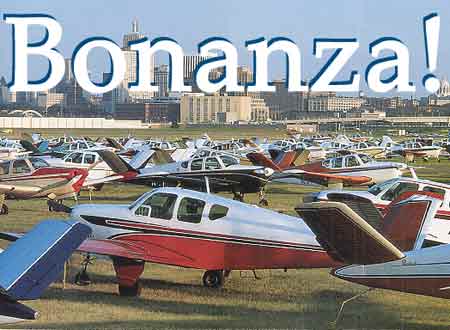
Budd Davisson, Plane and Pilot, February, 2001
"For both Beechcraft and the flying public the airplane was well named, as it's been a Bonanza for both."
Bonanza! It’s a name, an attitude AND an institution.
The Beechcraft Corporation selected that name for their new,
1945/46 design for a reason. They thought the word connotated
something bigger than expected. An airplane that would give
the pilot a windfall of pleasant surprises and utility. Looking
back 54 years to the airplane’s first flight it would
have to be said that the company couldn’t have picked
a more prophetic name. Also, the airplane proved to be as
much a Bonanza to the manufacturer as to the avid group of
pilots who cling to the “V” tailed icon (as well
as the straight tailed varieties) as if it were some sort
of aerial diety.
Before we go any further, let us give you the address and
phone number of the Bonanza Society. While we’re going
to lay out as many details as we can about the Wichita Wonder,
the Society is the go-to source for those seeking the final
word.
Bonanza History
When the war was winding down and it was obvious who the
winners would be, every airplane manufacturing plant in the
nation began looking to their future and what they would
do with all the skills and tooling they had used to win a
war. Also, there was a universal belief that the huge number
of returning military pilots, coupled with the GI’s
who could get government funding education , would comprise
a huge buying population for new aircraft designs. During
much of 1945, eveyr wartime producer had a small cadre of
engineers and designers working outside of their military
production duties to come up with “the” design
that would capture that new market.
At Beechcraft, VP of engineering, Ted Wells charged project
engineer Ralph Harman with the task of putting together a
small team to design an airplane that would take the company
into the post war period. They went through the same decision-making
process as every other manufacturer but decided to avoid
the trainer market and go right to the high end of the four
place market. In fact, Walter Beech wanted his new airplane
to set the standard for quality and performance. Clearly,
his design team accomplished their mission.
 They
actually designed and mocked-up several versions, including one with a conventional
tail, before aerodynamicist Jerry Gordon settled on a “V” tail configuration.
He reasoned it would produce less drag and weigh less, as well as providing
some advantages in preventing spins. The final design was actually produced
in two prototype forms, one airplane with a four cylinder, geared Lycoming
GO-290 of 160 horses and the Continental E-165 six cylinder. Additionally,
the Lycoming airplane had a laminar flow wing while the Continental airplane
used the better known 23000 series airfoil.
They
actually designed and mocked-up several versions, including one with a conventional
tail, before aerodynamicist Jerry Gordon settled on a “V” tail configuration.
He reasoned it would produce less drag and weigh less, as well as providing
some advantages in preventing spins. The final design was actually produced
in two prototype forms, one airplane with a four cylinder, geared Lycoming
GO-290 of 160 horses and the Continental E-165 six cylinder. Additionally,
the Lycoming airplane had a laminar flow wing while the Continental airplane
used the better known 23000 series airfoil.
In reality, the Bonanza was probably the first civilian airplane
to be so thoroughly tested prior to actually flying. Beechcraft
built their own 10 foot wind tunnel to test a number of designs
and did extensive fatigue and flutter tests on the airframe
before it was ever flown.
The final product, the Model 35 Beechcraft Bonanza, which
took to the air only two months after VJ Day, went on to
become a legend (obviously!) and set the standard for what
a four place airplane should be.
When an airplane is in production for over 50 years, it goes
through any number of modificatrions and changes, making
it difficult for a prospective buyer to know which model
is which. However, in terms of concept, the final V-Tailed
Bonanzas produced in 1982 are only slightly different than
the original Model 35. At the same time, those changes are
marked enough that they separate the airplane in to several
production-generations and are worth understanding. The straight-tail
follow on models, the 33 and 36, have their own modification
history to be unravelled.
A note about the prices presented here: they are Blue Book
numbers circa 2001 and generally represent a number lower
than you can actually find such an airplane on the market
for. They do, however, give an accurate picture of the aircraft
relative to one another.
GO TO NEXT PAGE